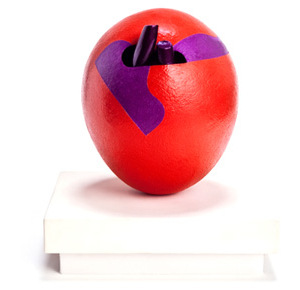Scripps College’s Ruth Chandler Williamson Gallery hosts a new exhibition from January 21 to April 8 highlighting the works of three giants in post-World War II ceramics whose works marked a “tectonic shift” in how the Western world viewed clay, said Mary Davis MacNaughton ’70, director of the gallery, at a recent lecture previewing the event.
Clay’s Tectonic Shift: John Mason, Ken Price and Peter Voulkos, 1956-1968 features key works of art of Mason, Price, and Voulkos. From 1956 to 1968, the three men created works of ceramic art that departed from the studio pottery tradition by claiming clay was a material as powerful as any for serious art work, MacNaughton said.
The exhibit is Scripps College’s contribution to the Getty initiative, Pacific Standard Time, which is an unprecedented collaboration of cultural institutions across Southern California. They have come together to celebrate the emergence of the city’s thriving art scene that evolved from the early postwar years to 1980.
“We are taking a fresh look at artists who have been seen individually, but not together in depth,” said MacNaughton, who is also associate professor of art history. “Each broke with tradition in his own way, through scale, intensity of color, and subject matter. They took what was happening in other areas of art, such as abstract painting, and incorporated it into their work.
“Seeing the works of these three artists together is a unique experience. It’s fascinating, too, to have the chance to see other Pacific Standard Time exhibitions that emphasize the accepted use of clay at that time, as a medium for creating practical, domestic items. After seeing those exhibits, viewers can even more clearly understand the revolutionary nature of the work of Mason, Price and Voulkos,” MacNaughton said.
She gave examples of how the three sculptors drew inspiration from other artistic sources in her December 14 presentation to the College’s Fine Arts Foundation at Scripps. Each artist drew from his own sources, which were as varied as the works of Picasso, and the philosophy of Zen. Mason looked to ancient pre-Columbian sculptures for insights on his own work, she said. Mason was also influenced by music, particularly jazz.
“Voulkos played classical guitar,” MacNaughton said. “Though Voulkos’ interest in music has been noted, little attention has been paid to the way it may have inspired his working method.”
Voulkos titled one of his pieces “Soleares,” which “refers to a particular rhythm of Spanish flamenco guitar,” MacNaughton said.
Price was a great fan of jazz icon Chet Baker.
“Price told me that he heard Baker at the Tiffany Club in downtown L.A.,” MacNaughton said. “He so admired Baker that he briefly studied with him.”
Just as these creative giants were inspired, Mason, Price and Voulkos continue to inspire new generations of artists. For more information on Pacific Standard Time, please click here.


